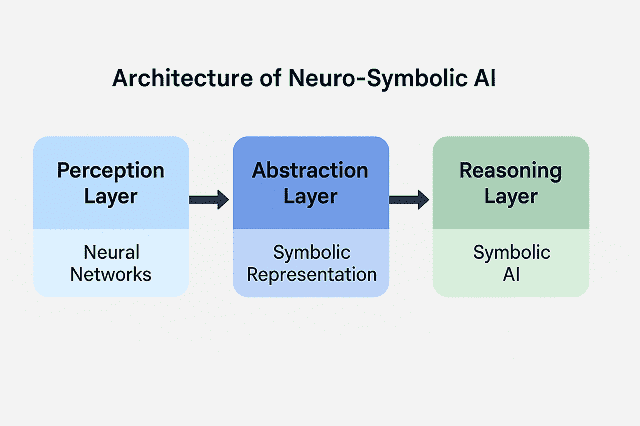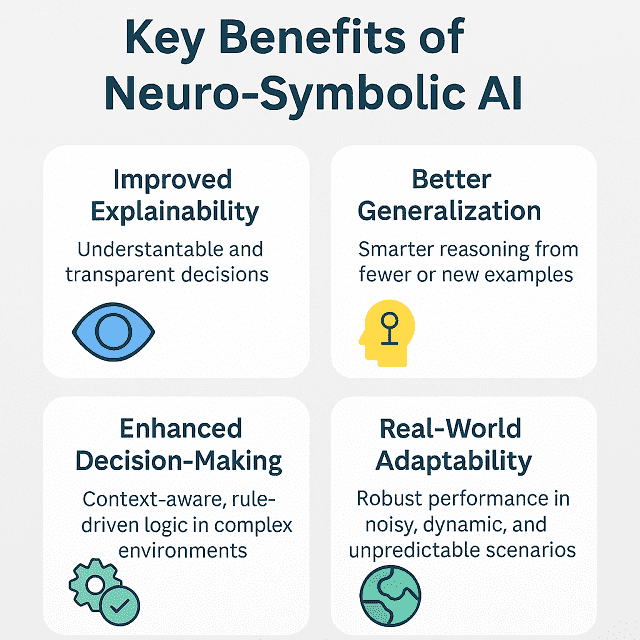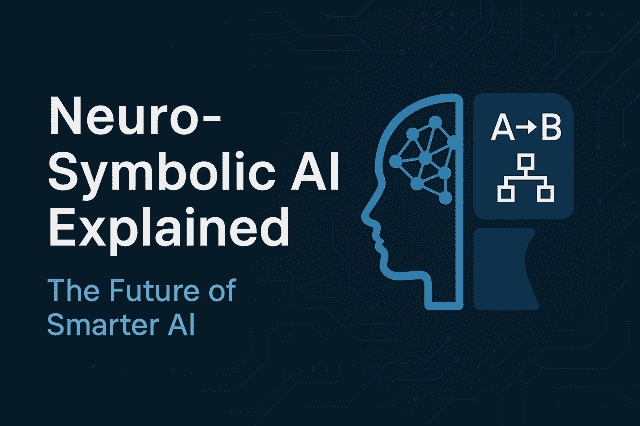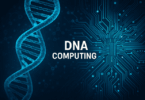What Is Neuro-Symbolic AI?
Artificial Intelligence has come a long way. It has grown from early rule-based systems to today’s data-driven neural networks. Yet, even now a persistent gap remains: how do we build machines that can not only learn from data but also reason like humans? This is where neuro-symbolic AI steps in.
Brief Definition of Neuro-symbolic AI
Neuro-symbolic AI is an emerging field. It combines the strengths of neural networks (pattern recognition and learning from data) with symbolic reasoning (logic-based decision-making and knowledge representation). In simple terms, it is a hybrid AI model that tries to get the best of both the flexibility of deep learning and the explainability of symbolic logic.
Why It is Gaining Traction
Despite their success, deep learning systems often act like black boxes. They are great at recognizing patterns. However, they are poor at explaining why a decision was made. This lack of transparency poses challenges in fields like healthcare, law, and finance. In those fields explainability and trust are critical.
Symbolic AI, on the other hand, offers clear rules and reasoning chains. However, they struggle with ambiguity and scalability.
Neuro-symbolic AI bridges this gap, offering:
- Explainable decision-making
- Better generalization from fewer examples
- Improved reasoning capabilities
As AI systems are increasingly deployed in high-stakes scenarios, the need for transparent, intelligent, and accountable AI is stronger than ever—driving the rapid growth of neuro-symbolic approaches.
How Neuro-symbolic AI Blends Symbolic Reasoning and Neural Networks
At the core of neuro-symbolic AI, there is a seamless integration between subsymbolic learning and symbolic reasoning.
- Neural networks process unstructured data like images, text, or audio to recognize patterns and features.
- Symbolic systems interpret this structured output using logical rules and predefined knowledge bases to reason, infer, and act.
This fusion allows machines to recognize that something is a cat. However, they also need to recognize the reason that if it is a cat and it is meowing, it might be hungry. That is bringing AI closer to human-like cognition.
The Evolution of AI: From Symbolic to Neural and Beyond
Artificial Intelligence has never been a single path of development. It has evolved through competing paradigms. Each paradigm comes with its strengths and limitations. They are from the early rule-based systems of symbolic AI to the current dominance of deep learning. Now, we move toward the integrated approach of neuro-symbolic AI. The trajectory reflects our increasing need for systems that are not only intelligent but also interpretable, reliable, and adaptive.
Symbolic AI in the Early Days
The first wave of AI, from the 1950s through the late 1980s, was dominated by symbolic reasoning. That is also known as Good Old-Fashioned AI (GOFAI). These systems were based on the idea that intelligence could be represented through symbols and manipulated by a set of explicitly programmed rules.
Key Features of Symbolic AI:
- Logical frameworks: Based on propositional and first-order logic.
- Manually crafted rules: Domain experts encoded rules to simulate decision-making.
- Structured knowledge: Represented via trees, graphs, or semantic networks.
- Inference engines: Used to derive new knowledge from known facts.
Early Examples:
- Logic Theorist (1956): Developed by Allen Newell and Herbert Simon. This was one of the first AI programs. It is capable of proving mathematical theorems.
- ELIZA (1966): A natural language processing system simulating a psychotherapist.
- MYCIN (1970s): A medical diagnosis system using over 450 rules to recommend treatments.
While symbolic systems were highly explainable, they were brittle:
- They required exhaustive rule sets for every possible situation.
- They could not easily adapt to new data or environments.
- Their performance degraded in the face of noise, uncertainty, or incomplete information.
This led researchers to seek more adaptive, data-driven approaches.
The Rise of Deep Learning
The limitations of symbolic systems opened the door for connectionist models, particularly neural networks. It is inspired by the structure of the human brain. The neural networks were theorized in the 1950s. However, they did not reach their full potential until the 2010s. Thanks to breakthroughs in computing power, data availability, and algorithmic innovation.
What Made Deep Learning Take Off:
- Big Data: Massive labeled datasets for training (ImageNet).
- GPUs: Enabled parallel processing for faster computations.
- Improved architectures: CNNs, RNNs, LSTMs, GANs, and Transformers.
- Open-source tools: Frameworks like TensorFlow and PyTorch democratized development.
Game-Changing Milestones:
- AlexNet (2012): Revolutionized image classification and won the ImageNet challenge.
- Google Translate (2016): Shifted to neural machine translation with huge accuracy gains.
- GPT Models (2018–2023): Redefined NLP capabilities using transformer-based architectures.
Despite their power, neural networks come with serious challenges:
- Opacity: They function as black boxes. That was making it hard to interpret decisions.
- Bias: They can learn and perpetuate social and historical biases present in training data.
- Data dependency: They require massive amounts of labeled data to function effectively.
AI systems began influencing healthcare diagnoses, legal decisions, credit scoring, and even autonomous weapons. Therefore, its demand for explainability, fairness, and reliability became critical.
The Need for Explainability and Hybrid Systems
To address these growing concerns, researchers turned to hybrid models that combine the learning ability of neural networks with the reasoning and transparency of symbolic logic.
This transition marks the birth of neuro-symbolic AI. Neuro-Symbolic is a promising paradigm that aims to create AI systems that can:
- Perceive and understand complex data
- Reason and infer with symbolic logic
- Explain their actions in human-understandable terms
- Generalize better from fewer examples
Why This Shift Is Inevitable:
- Transparency: In high-stakes domains, stakeholders need to understand and audit decisions.
- Data Efficiency: Symbolic reasoning helps reduce dependency on massive labeled datasets.
- Better Generalization: Rule-based reasoning allows AI to apply knowledge across domains.
- Regulatory Compliance: Laws like the EU AI Act push for explainable, trustworthy AI.
Real-World Examples of Hybrid AI:
- IBM’s Neuro-Symbolic Concept Learner: Combines visual perception with logical reasoning for tasks like image-based QA.
- MIT-IBM Watson AI Lab: Developing AI that uses logic-based programs to make neural networks more interpretable.
- OpenCog: A general intelligence framework combining neural nets and symbolic AI for cognitive modeling.
A Natural Next Step
The integration of symbolic and neural AI is not an academic exercise. It is a practical necessity. As we build machines that assist doctors, judge legal evidence, or operate self-driving cars, we must move toward systems that are not only accurate but also trustworthy and understandable.
Key Components of a Neuro-Symbolic System
Neuro-symbolic systems are built by integrating symbolic reasoning with neural network-based perception.
Let us explore the four foundational components that make these hybrid systems work seamlessly:
-
Symbolic Knowledge Base
This component acts as the logical foundation of the system.
- What it does: Stores rules, facts, ontologies, and structured representations of knowledge (“All humans are mortal”).
- Why it matters: Enables the AI to reason explicitly. Make inferences, and explain decisions based on a structured knowledge graph or logic-based format.
- Example: In healthcare, it might include medical ontologies and rules like “If temperature > 102°F and cough = true, suspect flu.”
-
Perception Layer (Neural Network)
This is the system’s learning and sensing component. Neural Network is its eyes and ears.
- What it does: Processes unstructured data like images, audio, or text, extracting meaningful features.
- Why it matters: Provides the contextual understanding necessary for symbolic reasoning to be applied.
- Example: A neural net might classify an image as showing a “cat,” and pass that concept to the reasoning engine for further logic-based decisions (“Cats are pets, hence not wild animals”).
-
Reasoning Engine
This is the logic processor of the neuro-symbolic system.
- What it does: Takes the output from the neural layer and applies symbolic rules to deduce, infer, or validate knowledge.
- Why it matters: It enables structured decision-making. It is essential for tasks that require step-by-step logic or explainability.
- Example: Given data on symptoms from the neural net, the engine might conclude: “Because A and B are true, then condition X is likely.”
-
Feedback Loop for Learning
This component closes the learning cycle and makes the system adaptive.
- What it does: Continuously updates both the neural and symbolic parts based on real-world feedback or contradictions.
- Why it matters: Keeps the system accurate, relevant, and up-to-date with dynamic environments.
- Example: If the symbolic rules do not hold up with new data patterns then the system can refine rules or retrain perception models accordingly.
These components, when integrated; create a system capable of both learning from data and reasoning with knowledge. It is this synergy that allows neuro-symbolic AI to achieve higher levels of intelligence, adaptability, and trustworthiness.
How Neuro-Symbolic AI Works
Neuro-symbolic AI is an innovative approach. It marries symbolic logic (good at reasoning and rules) with neural networks (masters of learning from data). This fusion allows machines not only to understand and generalize complex data but also to explain their reasoning. It is a major leap toward human-like AI systems.

Architecture Overview
At its core, a neuro-symbolic system consists of three key layers that transform raw input into logical, human-understandable decisions:
- Perception Layer (Neural Networks)
- Powered by deep learning models like Convolutional Neural Networks (CNNs) for image processing, or Transformers for text understanding.
- Extracts structured features from unstructured inputs.
- Example: Recognizing digits in an image or extracting entities from a sentence.
- Abstraction Layer (Symbol Generation)
- Converts feature into a symbolic form using mappings or abstractions.
- This includes converting the “image of a cat” to the symbol Cat (Entity123).
- Often implemented using graph representations or structured outputs from attention mechanisms.
- Reasoning Layer (Symbolic AI)
- Applies formal logic (first-order logic, description logic) or knowledge graph traversal to reason over the symbols.
- Enables goal-oriented tasks like deduction, planning, or constraint checking.
Example Architecture Flow:
Input: Image of a hospital room
Neural Layer: CNN detects bed, patient, monitor
Abstraction Layer: Converts to symbols: Bed (Entity1), Patient (Entity2)
Reasoning Layer: Applies rule: IF Patient(x) AND Bed(y) THEN In(x, y) → In(Patient, Bed)
Integration of Symbolic Logic and Neural Networks
The key strength of neuro-symbolic AI lies in its bidirectional integration—both bottom-up (neural → symbolic) and top-down (symbolic → neural):
Bottom-Up: Neural Supports Symbolic
- Neural models extract semantic structures from data: objects, relationships, and actions.
- These are passed to symbolic modules that verify consistency, reason over rules, or fill gaps in knowledge.
- Example: A system identifies drugs and dosages in clinical notes (via NLP). Then it uses medical logic to check for interactions.
Top-Down: Symbolic Guides Neural
- Symbolic rules can constrain the neural network’s predictions or guide training.
- Adds bias toward explainable outcomes, and avoids unreasonable inferences.
- Example: In computer vision, if Person (A) is “behind” Car (B), then A cannot be “in front of” B.
Why This Matters:
- Prevents AI hallucination (common in large language models).
- Allows training with less data (symbolic logic fills in structure).
- Improves safety, robustness, and interpretability in critical domains like law, healthcare, and finance.
Learning and Reasoning Together
What makes neuro-symbolic AI exceptional? The ability to learn from data and reason about knowledge—simultaneously makes it exceptional.
Learning
- Learns patterns from raw sensory input (sound waves, pixel values).
- Builds representations through training with labeled or unlabeled data.
Reasoning
- Uses logic-based rules to make decisions or infer new facts.
- Capable of causal, counterfactual, and commonsense reasoning.
Combined Strength
- Systems can generalize from small samples using domain knowledge (few-shot learning).
- Enables “zero-shot” inference: Example: knowing Cats are mammals, and Mammals give birth, one can deduce Cats give birth—without being explicitly told.
Real-World Applications Expanded
Autonomous Driving
- Neural nets detect road signs, vehicles, and pedestrians.
- Symbolic reasoning ensures compliance with traffic rules: “Stop if red light detected.”
Natural Language Understanding
- Neural components extract semantic meaning; symbolic modules enable deep Q&A, legal reasoning, or medical diagnosis.
- Example: IBM Watson combines NLP and symbolic logic for health advisory systems.
Finance & Fraud Detection
- Neural nets identify transaction patterns.
- Symbolic rules check for violations of regulatory constraints or unusual customer behavior.
Scientific Discovery
- DeepMind’s AlphaFold uses neural-symbolic ideas to predict protein structures by learning and applying biochemical rules.
Future Outlook
Neuro-symbolic AI is paving the way for:
- Trustworthy AI that can explain its actions.
- Robust systems that do not break in novel conditions.
- Knowledge-rich learning is where machines learn not only from data but also from principles.
Key Benefits of Neuro-Symbolic AI
Neuro-symbolic AI is not just another buzzword. It is a paradigm shift in artificial intelligence. It blends the data-driven learning of neural networks with logic-based reasoning. This hybrid approach unlocks new capabilities that were previously difficult to achieve. Let us explore why this emerging field is gaining momentum and how it is reshaping the future of intelligent systems.
- Improved Explainability: Opening the Black Box
One of the biggest criticisms of traditional AI, more particularly in Deep Learning is its opacity. When a neural network classifies an X-ray or flags a financial anomaly, it often cannot explain why it made that decision. This makes it difficult for developers, stakeholders, and regulators to trust the system.
Neuro-symbolic AI solves this by:
- Representing reasoning paths using symbolic rules and logic.
- Allowing the system to justify its conclusions in human-understandable terms.
- Making it easier to debug, audit, and refine the decision-making process.
Healthcare Example:
Instead of just diagnosing pneumonia based on pixel patterns, a neuro-symbolic system might explain:
“Detected fluid opacity in the lower lobe and elevated white cell count. These match the rule set for bacterial pneumonia.”
Why it matters: In regulated sectors like medicine, finance, or justice, transparency is not optional, but it is critical. Neuro-symbolic AI builds trust by making decisions that are both accurate and interpretable.
-
Better Generalization: Thinking Beyond the Training Data
Neural networks are great at recognizing patterns. But they are often data-hungry and prone to overfitting. They struggle in unfamiliar environments or when data is sparse. In contrast, neuro-symbolic AI leverages structured knowledge and logical inference to make smarter guesses.
This leads to:
- Robust performance in low-data or zero-shot scenarios.
- Ability to reason from known facts to derive new insights.
- Use of abstraction and prior knowledge to interpret new concepts.
Example:
A child might know that “tigers are mammals” and “mammals have backbones.” From that deduce “tigers have backbones.” Neuro-symbolic systems do this without being explicitly trained on that exact combination.
Education Tech Example: AI tutors can generalize better across new subjects using logical structures, without data memorization.
-
Enhanced Decision-Making: Smarter, Safer AI
AI systems used in mission-critical domains must not only act but act wisely and responsibly. Neuro-symbolic AI excels by combining data-driven learning with explicit rule-checking and causal reasoning.
This empowers systems to:
- Make context-aware decisions.
- Handle ambiguous or conflicting information.
- Perform commonsense and counterfactual reasoning—asking “what if?” and “why?”
Example in Autonomous Vehicles:
Imagine a car approaching a construction zone. A neural net might detect cones and barriers, but a symbolic engine reasons:
“If lane is closed and the detour sign points right, then re-route safely.”
In Legal AI: Systems can interpret contract clauses using NLP. They also apply legal precedence and logic to predict outcomes.
-
Real-World Adaptability: Learning and Evolving with Context
Real-world environments are messy. They are full of uncertainty, change, and nuance. Traditional AI models often fail when the conditions shift even slightly from what they were trained on. Neuro-symbolic systems are more resilient and adaptive.
They can:
- Integrate real-time data with static knowledge.
- Adapt behavior using symbolic rules without retraining.
- Function in open-world settings, where not everything is known in advance.
Example in Disaster Response:
A neuro-symbolic system can recognize a new emergency from sensor data (neural). Then it applies safety rules and planning protocols (symbolic) to prioritize human rescue.
Example in Manufacturing:
When a machine shows unusual vibration, the neural layer flags it. Then, the symbolic layer applies rules:
“If Vibration > X AND Temp > Y, then shut down the motor.”
This adaptability reduces downtime and avoids disaster.
Bonus: Synergistic Learning
Perhaps the most underrated benefit is how neural and symbolic parts can teach each other:
- Symbolic rules guide and regularize neural training.
- Neural insights can suggest new rules or exceptions to symbolic models.
- The system becomes self-improving It is growing its knowledge and accuracy over time.

Visual Summary: Benefits at a Glance
| Benefit | Impact |
| Explainability | Understandable and transparent decisions |
| Generalization | Smarter reasoning from fewer or new examples |
| Decision-Making | Context-aware, rule-driven logic in complex environments |
| Real-World Adaptability | Robust performance in noisy, dynamic, and unpredictable scenarios |
| Synergistic Learning | The mutual improvement between logic and learning for long-term performance |
Real-World Applications of Neuro-Symbolic AI
Neuro-symbolic AI is a theoretical innovation. However, it is already transforming real-world industries. It combines the intuitive learning power of neural networks with the precision and structure of symbolic reasoning. This hybrid approach enables AI systems to act smarter, reason better, and adapt to complex situations.
Let us explore how Neuro-Symbolic AI is being applied in four key areas.
Robotics and Autonomous Systems
In robotics, AI systems must operate in unstructured, dynamic environments. The dynamic environment can be like homes, warehouses, or streets. Where hard-coded logic alone is not enough. Neuro-symbolic AI helps robots learn from data and act on rules. That is leading to more intelligent and adaptable behavior.
Applications include:
- Autonomous drones navigate complex terrain using both spatial recognition (neural) and airspace rules (symbolic).
- Industrial robots adjust their behavior based on safety constraints and symbolic task plans.
- Household assistants understand commands and reasoning about their steps logically:
- “If the floor is wet, then do not vacuum until dry.”
Why it matters: These systems can both perceive their environment and reason through uncertainty. That is making them safer and more reliable in unpredictable scenarios.
Healthcare Diagnostics
In healthcare, explainability and trust are essential. Neuro-symbolic AI provides a clear rationale for decisions while still leveraging the massive amounts of data from medical records and imaging.
Real use cases:
- Medical imaging analysis that identifies patterns (neural) and validates them using symbolic clinical knowledge:
- “If patient age > 60 and lesion size > 1.5 cm, probability of malignancy increases.”
- Diagnosis support systems that combine patient symptoms with known disease ontologies for logical inference.
- Drug interaction checks using rule-based systems enhanced with predictive machine learning.
Benefits:
- More accurate diagnostics.
- Easier validation by doctors and regulators.
- Ethical AI that aligns with patient safety standards.
Natural Language Processing (such as Logical Inference)
Language is messy, nuanced, and rich in context and ambiguity. Traditional neural models often miss the deeper logic and structure inherent in language. Neuro-symbolic AI enables semantic understanding, rule-following, and contextual reasoning in NLP tasks.
Powerful applications:
- Question-answering systems that combine knowledge graphs (symbolic) with transformer models (neural) to produce fact-based answers.
- Chatbots and virtual assistants capable of understanding intent and applying procedural logic:
- “If the user asks for a refund AND purchase date > 30 days ago, deny the request.”
- Legal and policy document analysis where logical dependencies are critical.
Key outcome: From customer support to legal compliance, NLP systems can now understand, reason, and communicate more like humans.
Cognitive Computing
Cognitive computing aims to replicate human thought processes in machines. Neuro-symbolic AI is a cornerstone of this goal because it mimics the way humans combine intuition (neural) and logic (symbolic) to solve problems.
Applications include:
- Decision support systems in business, finance, and supply chain management.
- Cognitive agents that simulate human-like reasoning for simulations, games, or training.
- Digital twins of experts that learn from data but also apply symbolic domain knowledge to act like professionals.
Example: A financial advisor AI that suggests portfolios based on market trends (neural) while respecting regulatory constraints and investor profiles (symbolic).
Bridging the Gap between Theory and Practice
| Domain | How Neuro-Symbolic AI Helps |
| Robotics | Combines perception with task planning and safety rules |
| Healthcare | Delivers explainable, rule-based diagnostics with predictive power |
| Natural Language | Enables structured inference, rule-following, and rich semantic analysis |
| Cognitive Computing | Simulates human-like thinking and supports complex decision-making |
Challenges in Neuro-Symbolic AI
Neuro-symbolic AI sits at the frontier of artificial intelligence. It aims to bridge perception and reasoning. But despite its promise, it faces formidable challenges. These are not just academic hurdles. However, they directly impact real-world deployment, scalability, and trust in AI systems.
-
Complexity in Integration
Neuro-symbolic integration combines sub-symbolic methods (like deep learning) with symbolic approaches (like logic-based reasoning or knowledge graphs). However, these paradigms operate differently:
Incompatibility in Representations:
- Neural networks learn distributed, non-interpretable representations in vector space.
- Symbolic systems rely on discrete symbols, often with clear semantics (“IF x THEN y”).
Bridging these requires translation layers, mapping functions, or shared embedding spaces. These are still evolving and not always robust.
Architectural Complexity:
- Hybrid models like DeepProbLog, Neural Theorem Provers, or Logic Tensor Networks try to combine both. However, they are hard to generalize across domains.
- They often require custom neural modules, hand-crafted rules, or specialized training procedures that increase implementation effort.
Real-World Example:
In autonomous driving, an AI might use neural perception for object detection and symbolic rules for legal compliance (“stop at a red light”). Synchronizing these two systems in real-time without ambiguity is a non-trivial engineering challenge.
-
Computational Overhead
Neuro-symbolic systems are computationally intensive because they must:
- Train neural networks with large datasets,
- Execute symbolic inference (often sequential and non-parallelizable),
- And sometimes perform both simultaneously or in iterative loops.
Key Performance Limitations:
- Memory Usage: Symbolic graphs + neural weights = high RAM/VRAM requirements.
- Latency: Reasoning steps cannot be accelerated by GPUs easily. Even modern symbolic engines (like Answer Set Programming) are not optimized for speed.
- Training Complexity: Models like NeuroLogic AIs require symbolic constraints during backpropagation. That slows learning and demands custom loss functions.
Industry Insight:
In robotic planning or legal tech, AI needs to reason over a body of knowledge. Purely neural models are fast but blind to logic. Symbolic models are smart but slow. Fusing them currently leads to “the worst of both worlds” unless optimizations are introduced.
-
Lack of Standard Frameworks
The ecosystem for neuro-symbolic AI is still in its early experimental phase. It is not like mature domains like NLP or computer vision where you can plug in pre-trained models or datasets.
Barriers to Entry:
- Few ready-to-use libraries: Tools like PyKEEN, LogicNets, and NeuralLP However, they are not widely adopted or user-friendly.
- Custom pipelines: Often, research labs or companies need to build their own symbolic engine interface with TensorFlow or PyTorch.
- No common benchmarks: ImageNet for Computervision or GLUE for NLP, but there is no universally accepted benchmark for hybrid reasoning tasks.
Fragmented Research:
- Some approach are symbolic-first (logic programming with neural components).
- Others are neural-first (neural networks augmented with constraints).
- There is no consensus on best practices or even a common definition of “neuro-symbolic.”
Expert Observation:
Top researchers from IBM and MIT, emphasize that standardization is key for adoption. Without reusable tools and cross-domain compatibility, neuro-symbolic AI risks remaining an academic curiosity.
| Challenge | Underlying Issues | Real-World Impact |
| Complexity in Integration | Differences in data types, architectures, and training logic | Slows down development and increases engineering effort |
| Computational Overhead | Symbolic reasoning is CPU-bound; neural models are GPU-bound | Expensive to train and difficult to scale to real-time applications |
| Lack of Standard Frameworks | Fragmented toolsets, few benchmarks, no unified practices | Limits collaboration, productization, and open innovation |
Tools, Frameworks & Libraries for Neuro-Symbolic AI
Recently neuro-symbolic AI has gained traction. Therefore, a growing set of tools and platforms enables researchers and developers to implement hybrid systems. The hybrid systems combine learning with reasoning.
Below are some of the most significant ones in the space:
IBM’s Neuro-Symbolic Concept Learner (NS-CL)
Overview:
NS-CL is a research project by IBM. The NS-CL combines deep learning-based perception with symbolic program execution to answer complex questions about visual scenes.
Key Features of NS-CL:
- Uses semantic parsing to transform natural language into logical forms.
- Combines this logic with perceptual data extracted from images.
- Can answer visual questions. It can justify its answers. Even it can adapt to novel tasks.
Why it matters:
- Demonstrates explainable visual reasoning.
- A pioneering example of blending perception and logic to handle real-world tasks.
LNN (Logic Neural Networks)
Overview:
Logic Neural Networks Developed by IBM Research. LNNs integrate first-order logic directly into neural network structures.
Key Features:
- Logical connectives (AND, OR, NOT) are differentiable.
- Supports incomplete or uncertain information.
- Trains using standard backpropagation while respecting logic constraints.
Why it matters:
- Enables soft logic constraints in learning.
- Ideal for tasks needing logical consistency and neural adaptability like safety-critical systems.
OpenCog
Overview:
An open-source general intelligence framework supports symbolic and probabilistic reasoning.
Key Features:
- Includes AtomSpace, a knowledge base for storing semantic relationships.
- Supports pattern mining, inference, and learning.
- Designed for AGI (Artificial General Intelligence) experiments.
Why it matters:
- Strong emphasis on symbolic reasoning and cognitive modeling.
- Great for building large-scale hybrid systems with memory, logic, and learning modules.
Pyke (Python Knowledge Engine)
Overview:
A Python-based expert system leverages logic programming and rule engines.
Key Features:
- Enables symbolic logic programming using forward and backward chaining.
- Easy to integrate with Python-based neural models.
- Lightweight and readable syntax.
Why it matters:
- Ideal for prototyping rule-based systems.
- Allows symbolic reasoning to be embedded into Python-driven ML workflows.
Bonus Mentions
- DeepProbLog: A probabilistic logic programming tool that incorporates neural predicates.
- DiffLog: Differentiable logic programming for neural-symbolic integration.
- NeSy: A community-driven ecosystem focusing on unifying logic and learning.
Leading Research & Industry Projects
Neuro-Symbolic AI continues to gain traction. Therefore, several pioneering institutions and companies are pushing the boundaries of what is possible. These efforts are not just academic. They are laying the foundation for real-world, explainable, and intelligent systems that blend logic with learning.
IBM’s Neuro-Symbolic Concept Learner (NS-CL)
IBM has been a torchbearer in developing explainable AI through its Neuro-Symbolic Concept Learner. That is particularly showcased in its collaboration with MIT-IBM Watson AI Lab.
Key Features:
- Combines deep learning for perception (image understanding) with symbolic reasoning for logical decision-making.
- Designed primarily for Visual Question Answering (VQA) tasks. The system can interpret images and answer complex, multi-step logical questions.
Example:
Given an image of a room with various objects, NS-CL can answer:
“Is the red cube to the left of the green cylinder?”
This requires object recognition (neural) + spatial reasoning (symbolic).
Why It Matters:
- Demonstrates compositional generalization. The ability to solve tasks it has not explicitly seen before.
- Enables explainability: users can trace back the system’s answers to symbolic reasoning steps.
MIT and Stanford Research
Both MIT and Stanford are deeply involved in advancing the theory and application of neuro-symbolic systems.
MIT Research Highlights:
- Focus on hybrid models that embed logic constraints into deep learning training.
- Development of systems like Scene Graphs. It merges structured representations with neural networks.
Stanford AI Lab Initiatives:
- Work on Neural Theorem Provers (NTP). In it, the systems that learn logic rules from data and perform symbolic inference using neural architectures.
- Research in causal reasoning, probabilistic logic, and multi-hop QA to blend statistical learning with structured logic.
Shared Focus:
- Improving interpretability, compositionality, and sample efficiency.
- Creating systems that learn like humans. It learns through both perception and reasoning.
Open-Source Initiatives
A growing ecosystem of open-source tools and research platforms makes neuro-symbolic AI more accessible to developers and researchers.
Notable Projects:
- DeepProbLog (KU Leuven):
- Combines Prolog (symbolic) with deep neural modules for probabilistic reasoning.
- Useful in domains like robotics, NLP, and computational law.
- NeSy (Neuro-Symbolic) Vision:
- Frameworks that support tasks like VQA and symbolic segmentation using hybrid learning.
- Neural Logic Machines (Tsinghua University):
- Unifies neural learning with rule-based logic operations.
- PyKEEN:
- Though focused on knowledge graph embedding, it enables symbolic reasoning tasks with neural integration.
Importance of Open Source:
- Accelerates collaborative innovation.
- Enables benchmarking across tasks like logical reasoning, concept learning, and hybrid planning.
- Provides low-barrier entry points for researchers and startups.
| Entity | Project/Tool | Core Contribution |
| IBM | Neuro-Symbolic Concept Learner | Explainable hybrid reasoning on visual data |
| MIT | Scene graphs, hybrid logic models | Structured perception and compositional reasoning |
| Stanford | Neural Theorem Provers | End-to-end differentiable logic learning |
| KU Leuven | DeepProbLog | Probabilistic logic programming with deep learning |
| Tsinghua University | Neural Logic Machines | Symbolic reasoning with neural modules |
| Open Source | PyKEEN, NeSyVision, Logic Tensor Networks | Accessible tools for hybrid AI research and development |
Neuro-Symbolic AI vs. Traditional AI Models
The field of Artificial Intelligence has evolved through distinct paradigms. Those paradigms are Symbolic AI and Neural AI. Now the emerging hybrid of the two evolved is Neuro-Symbolic AI. Each comes with its own strengths, limitations, and ideal use cases.
Comparison Table: Symbolic AI vs. Neural AI vs. Neuro-Symbolic AI
| Feature / Aspect | Symbolic AI | Neural AI (Deep Learning) | Neuro-Symbolic AI |
| Data Requirement | Low – rule-based | High – data-driven | Moderate – combines data & knowledge |
| Explainability | High–transparent rules | Low–black–box models | High–reasoning paths can be traced |
| Learning Capability | Limited – hard-coded rules | Strong – learn patterns from data | Strong – learns & reasons simultaneously |
| Generalization | Poor – brittle when data changes | Moderate – good with large data | High – combines pattern & logical learning |
| Symbolic Reasoning | Native – uses formal logic | Absent – doesn’t reason explicitly | Integrated – symbolic modules + learning |
| Perception (Vision) | Weak – needs structured input | Strong – excels in raw data tasks | Strong – adds reasoning to perception |
| Adaptability | Low – needs manual updates | Moderate – retrains on new data | High – dynamically adapts to logic rules |
| Use Cases | Expert systems, planning | Image recognition, NLP, game AI | Robotics, healthcare, cognitive systems |
Strengths and Weaknesses of Each
Symbolic AI
- Strengths:
- Fully explainable
- Effective in well-defined, rule-based environments
- Ideal for reasoning, planning, and formal logic tasks
- Weaknesses:
- Rigid — fails in ambiguous or unstructured environments
- Requires manual encoding of knowledge
- Poor scalability with large or noisy datasets
Neural AI (Deep Learning)
- Strengths:
- Excellent pattern recognition
- Can process vast, unstructured data (images, audio, text)
- Learns features automatically from raw inputs
- Weaknesses:
- Lack of transparency — difficult to interpret
- Data-hungry — requires massive labeled datasets
- Struggles with logical reasoning and generalization beyond training data
Neuro-Symbolic AI
- Strengths:
- Merges perception (neural) with reasoning (symbolic)
- Balances learning with explainability
- Handles novel situations using logic, even with limited data
- Offers improved trust and accountability in AI decisions
- Weaknesses:
- Architecturally complex — requires tight integration of disparate systems
- Still in early stages — fewer standardized tools and benchmarks
- Computationally more demanding than traditional approaches
Neuro-Symbolic AI represents a convergence of two powerful traditions. Those traditions are the rigor and interpretability of symbolic logic and the adaptive intelligence of neural networks. Symbolic and neural models have individually shaped AI’s evolution. However, their hybrid promises a future where machines can see, learn, and reason — just like humans.
Ethical Implications & Societal Impact of Neuro-Symbolic AI
AI systems become more integrated into critical aspects of society. Therefore, the need for ethical and accountable AI becomes increasingly urgent. Neuro-symbolic AI offers promising advancements toward more responsible technology.
Bias Reduction through Logical Reasoning
One of the most pressing concerns in AI today is bias. It is often baked into training data used by neural networks. Biases can lead to unfair outcomes. Further, they can manipulate sensitive domains like hiring, lending, and criminal justice.
How Neuro-Symbolic AI helps:
- Rule-based logic can act as a check on learned behavior. If a neural model starts favoring biased patterns then symbolic reasoning can intervene and correct decisions based on fair, predefined rules.
- The transparent nature of symbolic reasoning makes it easier to audit decision paths. It allows humans to spot and fix bias more effectively.
- Hybrid systems can be trained to align decisions with ethical guidelines or laws. They are reinforcing fairness.
Example: In loan approvals, a symbolic layer can enforce that “gender” or “race” must not influence outcomes, even if the neural model learns biased associations.
Safer AI Decision-Making
Traditional deep learning models are often black boxes. However, it is more powerful but opaque. In high-stakes environments, this lack of transparency poses risks.
How Neuro-Symbolic AI improves safety:
- Explainability: Symbolic components can trace how a decision was made. It offers clear justification for actions taken.
- Predictability: Logical rules ensure that AI will not behave in unexpected or dangerous ways. Predictability is crucial in applications like autonomous vehicles or medical diagnostics.
- Human-aligned reasoning: Logical constraints can guide AI behavior to align more closely with human values, norms, and laws.
Example: In healthcare, an AI recommending a treatment must not only be accurate but also able to justify its choice with clinical guidelines. It is a task well-suited for neuro-symbolic systems.
The Bigger Picture
By bridging learning with logic, neuro-symbolic AI has the potential to shape a future where AI systems are not just smart, but also ethical, explainable, and socially responsible. These systems become more prevalent. However, they can help build public trust in AI and encourage broader adoption across critical sectors.
The Future of Neuro-Symbolic AI
Neuro-symbolic AI represents a powerful synthesis of the two dominant paradigms in artificial intelligence: symbolic reasoning and neural learning. As the world demands AI systems that are not just accurate but also transparent, adaptable, and human-aligned, neuro-symbolic approaches are emerging as the most promising path forward.
Trends to Watch
-
Standardization and Ecosystem Growth
The future success of neuro-symbolic AI hinges on accessible tools and standardized protocols. Institutions like IBM, Stanford, and MIT are developing toolkits that abstract the complexity of hybrid models and make them usable for developers across domains. We are likely to see the following developments:
- Unified APIs for integrating symbolic logic with neural backend.
- Plug-and-play reasoning modules compatible with major frameworks like PyTorch and TensorFlow.
- A growing number of open-source platforms (like NeSy, NeuroLog, and DeepProbLog).
-
Neuro-Symbolic AI at the Edge
It has raised interest in edge AI. It can be deploying intelligence on devices like drones, mobile phones, and wearables. Neuro-symbolic systems are being optimized for lightweight inference with high interpretability. For instance, in smart surveillance, a neuro-symbolic model can detect anomalies. Further, it can also explain them in a human-readable format.
-
Industry Convergence
We will see increasing convergence in sectors where interpretability is critical. In finance, neuro-symbolic AI could be used to justify investment decisions. In law, it could support legal reasoning. And in defense, it could help autonomous systems comply with international humanitarian laws.
-
Emergence of Modular Intelligence
Rather than large monolithic models, the trend will shift towards modular AI systems. Neuro-symbolic architectures allow for specialized components. It can be employed in vision handled by neural networks, logic by symbolic engines, and decision-making through a hybrid controller.
-
AI-Assisted Scientific Reasoning
Imagine AI not just analyzing data but hypothesizing theories in particle physics, biology, or medicine. This is where neuro-symbolic AI shines. It can understand formal logic, and generate hypotheses. It can test them, all while learning from observed patterns.
Impact on AGI (Artificial General Intelligence)
The limitations of traditional deep learning (poor generalization, massive data dependence, lack of reasoning) make neuro-symbolic AI a key candidate for AGI architectures.
- Symbolic Reasoning Enables Generality
- AGI requires systems that can reason across domains. It is an ability rooted in symbolic logic, not in brute-force learning.
- Combining Intuition with Logic
- Human cognition is not just about pattern recognition (neural nets); it is about combining perception with structured reasoning. Neuro-symbolic AI mimics this dual-system thinking. It combines intuition (fast, learned behavior) with deliberation (rule-based logic).
- Precision with Adaptability
- Neuro-symbolic systems can rapidly adapt to new environments, even with limited data. Thanks to their ability to apply previously learned rules or logic trees.
- Example: Solving Math Word Problems
- Recent models use neural systems to parse language and symbolic engines to solve algebra. That is showcasing the kind of flexible, multi-modal intelligence needed for AGI.
Why It Matters for the Future of AI Safety
AI is used in high-stakes applications like criminal justice, autonomous warfare, and public policy. Therefore, AI safety is increasingly urgent.
Transparency and Trustworthiness
Neuro-symbolic systems provide traceable decision paths, unlike black-box neural networks. This is essential for earning human trust in domains like healthcare and aviation.
Correcting and Controlling AI Behavior
With symbolic constraints, developers can directly inject ethical principles, business rules, or legal requirements into an AI model. That can be injected without retraining from scratch.
Bias Mitigation
Neural models often absorb biases from data. With neuro-symbolic models, logic-based constraints can override or flag problematic inferences. That is reducing societal harm.
Human-AI Collaboration
Because neuro-symbolic AI can explain its reasoning in natural or symbolic terms, it becomes easier for humans to validate, question, or collaborate with these systems in real-time.
Neuro-Symbolic AI: An Essential Step Forward
In the coming decade, neuro-symbolic AI could be the linchpin for achieving:
- Reliable autonomous vehicles that reason about edge cases.
- Clinical decision systems that combine data with medical guidelines.
- Educational tutors adapt like humans and explain like teachers.
- Scientific assistants that reason like domain experts.
Researchers, developers, and policymakers continue to shape the AI landscape. The neuro-symbolic models will play a pivotal role in creating systems that are not only intelligent but also trustworthy, safe, and aligned with human values.
Conclusion: A Step Toward Human-Like Intelligence
Recap of Importance
Neuro-symbolic AI is more than just a technological innovation. It is a paradigm shift in how we design and understand intelligent systems. It combines the learning power of neural networks with the structured reasoning of symbolic AI. This approach brings us closer to building AI that thinks and learns more like humans. It addresses the limitations of traditional methods by offering:
- Transparency in decision-making
- Generalization to new problems
- Adaptability to real-world complexity
- Ethical alignment through logical constraints
Neuro-symbolic AI is redefining what is possible—and what is responsible.
Encouragement to Follow the Topic
This field is rapidly evolving. Therefore, staying updated is essential. Neuro-symbolic AI sits at the intersection of logic, learning, and cognition. The breakthroughs happening today will shape the next generation of AI systems. If you are a developer, researcher, student, or enthusiast this is the perfect time to dive deeper.
- Follow leading research labs like IBM, MIT CSAIL, and Stanford AI Lab.
- Explore open-source projects and toolkits
- Engage with academic papers and technical blogs
- Watch for real-world applications in areas that matter to you
We would love to hear your thoughts!
- What excites you most about neuro-symbolic AI?
- Do you see it playing a role in your work or industry?
- What challenges or questions do you think still need to be solved?
Join the conversation below and let us explore the future of intelligence together.
Frequently Asked Questions on Neuro-Symbolic AI
Q1: What is neuro-symbolic AI in simple terms?
It is a hybrid approach that combines neural networks (which learn from data) with symbolic reasoning (which follows logic and rules). This blend helps AI systems become smarter, more explainable, and more human-like in their reasoning.
Q2: Why is neuro-symbolic AI important?
Because it bridges the gap between learning and logic. Neural networks are great at recognizing patterns. However, they lack reasoning abilities. Neuro-symbolic AI enables systems to learn like humans but also explain their decisions. That makes them more trustworthy and useful in complex tasks.
Q3: Who is using neuro-symbolic AI today?
Leading tech companies and universities are at the forefront. IBM (with its Neuro-Symbolic Concept Learner), Microsoft Research, MIT, and Stanford are just a few examples of actively exploring this field and developing real-world applications.
Q4: Is neuro-symbolic AI the future of Artificial Intelligence?
Many experts believe so. It addresses the major weaknesses of both symbolic and neural approaches. By combining logic with learning, neuro-symbolic systems are better equipped to handle complex, real-world scenarios. That makes them crucial for the development of safe and general AI in the future.
Q5: What are the career opportunities in neuro-symbolic AI?
There is a growing demand for interdisciplinary talent. Roles span from AI research and machine learning engineering to logic programming and cognitive science. Those with a mix of deep learning knowledge and formal logic experience will be valuable in academia, industry, and startups.
Q6: Are there any open-source tools or libraries for neuro-symbolic AI?
Yes! Projects like DeepProbLog, NeSy, and IBM’s Neuro-Symbolic Concept Learner offer frameworks for building hybrid models. While the field is still maturing, the open-source community is starting to grow around it.
Q7: How does neuro-symbolic AI improve AI safety?
By making AI behavior more transparent and controllable. Symbolic reasoning introduces constraints and rules. That is reducing unpredictable behavior often seen in black-box models. This is essential in safety-critical domains like healthcare, finance, and autonomous systems.







